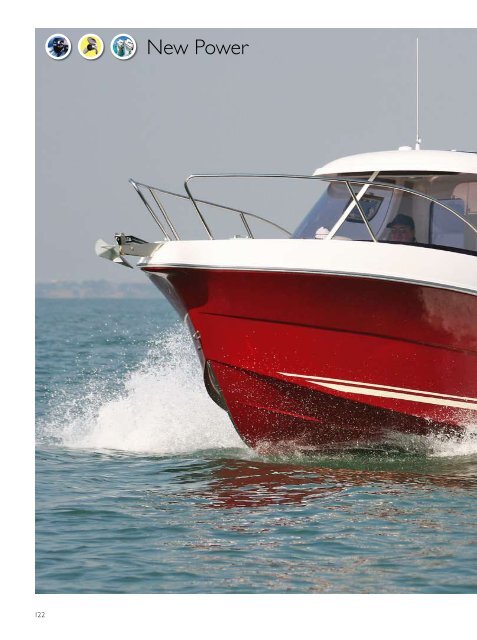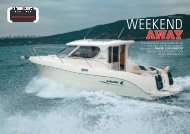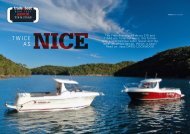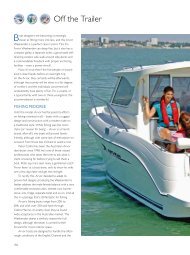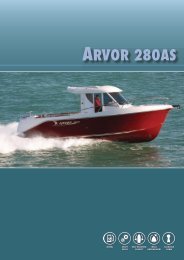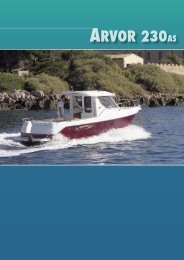New Power - Arvor 280AS
New Power - Arvor 280AS
New Power - Arvor 280AS
Create successful ePaper yourself
Turn your PDF publications into a flip-book with our unique Google optimized e-Paper software.
122<br />
<strong>New</strong> <strong>Power</strong>
Simple,<br />
n’est-ce pas<br />
The distinctly-styled <strong>Arvor</strong> 215AS is a<br />
boat with a lot to offer Aussie boaties.<br />
By Chris Beattie<br />
123
Simplicity is a virtue. But in a boat it is,<br />
increasingly, a rarity. Advances in electronics,<br />
engines and other knick-knacks and widgets have<br />
resulted in trailer boats that have become more<br />
and cluttered with gear and technology. And<br />
consumer demand for more creature comforts<br />
has likewise contributed to crowding more and<br />
more gear into smaller and smaller boats. For<br />
many, this is a good thing. But equally, for those<br />
wanting a simple experience on the water, it is not.<br />
It offers an all-weather sanctuary<br />
for occupants and a spot of<br />
comfort for overnighting<br />
Which brings us to the <strong>Arvor</strong> range of boats.<br />
The uniquely-styled, French-designed craft have<br />
been brought into Australia for the last 11 years<br />
by Collins Marine, in Alexandria, NSW. The<br />
Australian range runs from the smallest <strong>Arvor</strong><br />
20 – which is actually built in Nowra under<br />
licence by Collins Marine – up to the flagship<br />
<strong>280AS</strong>. All boats run shaft-drive diesel inboard<br />
drivelines boasting frugal fuel consumption and<br />
good overall performance from their semidisplacement<br />
hulls.<br />
We’ve tested <strong>Arvor</strong>s in the past and our<br />
writers have been unanimous in their praise for<br />
these distinctive craft. From good seaworthiness<br />
to practicality and ergonomic efficiencies, our<br />
testers have liked what they’ve seen. Not having<br />
had the pleasure myself, I was quick to take up<br />
the offer to try one when the folks at Phillip<br />
Island Marine invited me down for a spin on the<br />
company’s latest creation, the 215AS.<br />
WORTH A VISIT<br />
Firstly, I must say that Phillip Island Marine is well<br />
worth a visit in its own right, hidden away as it is<br />
in the tranquil hamlet of Rhyll, on the north side<br />
of the island. MD Scott Huther and his helpful staff<br />
have a large inventory of anything you’re likely to<br />
need for boating and fishing around the island, are<br />
open seven days a week, are a mere stone’s throw<br />
from the boat ramp and can supply fuel, too.<br />
Scott and sidekick, Wayne Bain, who owns<br />
his own <strong>Arvor</strong> 20AS, explained that <strong>Arvor</strong>s are<br />
becoming increasingly popular for boaties who<br />
tend to use their boats a fair bit and value ease of<br />
maintenance and low running costs.<br />
Having heard a bit about <strong>Arvor</strong> sea handling<br />
abilities, I had mixed feelings about the state of<br />
nearby Westernport waters on the day. The bay<br />
was about as flat as it ever gets, with a balmy early<br />
Autumn cloudless day adding to the pristine, boatfriendly<br />
conditions. Great for a lazy cruise or for<br />
wetting a line and working on the tan, but pretty<br />
much useless for determining how a boat reacts<br />
to an angry sea. So I had to be content to enjoy<br />
the near-perfect conditions and rely on previous<br />
tester’s comments, which were all complimentary<br />
about the <strong>Arvor</strong> hull’s seakeeping and handling<br />
characteristics. All I can say with confidence after<br />
an hour or so spent on a billiard table-smooth<br />
Westernport is that the <strong>Arvor</strong> 215AS handles<br />
a smooth sea, well … smoothly.<br />
124
But first things first. Before we departed<br />
the ramp, Wayne gave me a tour of the boat,<br />
pointing out various features, beginning with the<br />
wheelhouse and cabin.<br />
ALL-WEATHER SHELTER<br />
Entered via a sturdy sliding and lockable door, the<br />
215AS’s interior is spacious for a boat of its length.<br />
It offers an all-weather sanctuary for occupants<br />
and a spot of comfort for overnighting, courtesy<br />
of an infill cushion that provides a double berth.<br />
A porta-pottie adds convenience and there is a<br />
small sink console, with a moulded indentation for<br />
a standard equipment single-burner gas stove.<br />
There is storage room aplenty, with parcel<br />
shelves in the bow and next to the skipper’s perch,<br />
as well as under-cushion space. In addition, there<br />
is a large open cavity on the starboard side of the<br />
cabin floor.<br />
From a skipper’s point of view, there is a lot<br />
to be said for the helm, with gobs of visibility in<br />
pretty much every direction. The dash is simple<br />
and straightforward, with a couple of Mercury<br />
SmartCraft gauges informing the boss about a<br />
variety of functions, from engine rpm, to fuel<br />
consumption and level and oil temperature.<br />
Two switch panels handle everything from nav<br />
lights to livebait and bilge pumps, while there is<br />
a rather large red knob, labelled a ‘Trolling-Valve’,<br />
at the top of the dash. Its function is to offer fine<br />
low-speed control when trolling lures.<br />
The throttle is within easy reach and there<br />
is adequate storage in the way of parcel shelves<br />
directly adjacent to the helm. Skipper and<br />
companion can either stand or sit in a pair of folddown<br />
seats, while a clever and simple – there’s<br />
that word again – pole slots into raised mouldings<br />
in the floor to provide an optional foot brace.<br />
Overhead on our test craft was an optional<br />
M84 Northstar chartplotter/sounder, with<br />
Above: The asymmetrical<br />
placement of the wheelhouse<br />
confers a wide starboard bow<br />
walk-around.<br />
Below: The helm area is<br />
compact, but fitted with an<br />
array of standard electronics.<br />
125
SLIME<br />
slowing you<br />
down<br />
Boat Sure<br />
ULTRASONIC ALGAE CONTROL<br />
See us at the<br />
Sydney Boat Show!<br />
Destroys algae<br />
• Emits ultrasonics through your hull<br />
• Reduces algae and bio-film build-up<br />
• Improves antifouling performance<br />
• Extends the period between cleaning<br />
• Suits fibreglass and metal hulls<br />
1<br />
2<br />
3<br />
Glue<br />
Locking Ring inside hull<br />
No drilling or slipping<br />
Screw<br />
Transducer into Ring<br />
Can be relocated<br />
Connect<br />
Control Box to your battery<br />
Draws 1.2-2.0A at 12V<br />
BoatSure.com.au<br />
Phone: (03) 9335 3577<br />
additional standard electronics, in the form of a<br />
GME GR9000 marine stereo unit and a Northstar<br />
Explorer VHF radio.<br />
Wheelhouse height is close to 2m, so unless<br />
you’re an NBA basketballer, your hairdo is safe,<br />
although it can get a little squeezy if two regularsized<br />
adults are attempting to swap places around<br />
the confines of the helm area.<br />
WIDE WALKAROUND<br />
Space is certainly not a problem outdoors,<br />
though. Nearly all Avors boast a wide and deep<br />
starboard-side walkaround for forward access,<br />
hence the ‘AS’ designation, which refers to the<br />
asymmetrical placement of the wheelhouse.<br />
There is a stack of room to access the bow,<br />
enhanced by sturdy and high bowrails. Generally,<br />
though, most people won’t go further forward<br />
than the wheelhouse, as the <strong>Arvor</strong> 215AS is<br />
sensibly equipped standard with an electric<br />
windlass operated from the helm.<br />
The self-draining cockpit is an expansive,<br />
uncluttered area, save for the raised engine hatch,<br />
although its angular and curved lines do not<br />
provide too much of an obstacle to movement.<br />
Seating is provided by foldaway wooden slat<br />
bench seats; a twin seat in the starboard coaming<br />
and a single in the port rear corner, above which is<br />
a compact tackle drawer. In the opposite corner is<br />
a compact storage locker.<br />
Both gunwales sport teak inset planks in<br />
which are housed stainless steel rodholders,<br />
with an additional pair of holders in the transom.<br />
I’m thinking there would be an opportunity for<br />
stainless craftsmen to market a rocketlauncher to<br />
run across the back of the wheelhouse roof for<br />
extra rod storage for serious piscatorial pursuits.<br />
Outboard of the teak gunwale insets are rollers,<br />
which are quite a normal addition for Europeans
hauling nets and pots, but not likely to see as<br />
much use here.<br />
A spacious kill tank resides on the port side<br />
cockpit floor, while a quite large plumbed livebait<br />
tank is nestled into the transom, beyond which is<br />
a sturdy swim platform, complete with a boarding<br />
ladder and auxiliary outboard engine mount –<br />
a sensible touch for anyone who spends a lot of<br />
time fishing out of sight of land.<br />
From a fishing perspective, the relatively high<br />
coamings offer good leverage, although it’s a bit of<br />
a reach to the water if you have to spend any time<br />
manhandling large fish in close quarters.<br />
SOLO STEERER<br />
Along with the trolling throttle control, the 215AS<br />
also has a manual tiller attachment in the transom,<br />
which makes it a great craft for solo skippers who<br />
need to be able to run their boat from the cockpit.<br />
Engine access is via the large hatch in the<br />
centre of the cockpit floor. It opens to reveal<br />
a very low-set, 115hp Cummins MerCruiser<br />
common rail diesel engine driving through a shaft<br />
that emerges at a very shallow angle and spins a<br />
prop located at the end of an angled keel. The<br />
propeller is afforded some protection by a metal<br />
brace that extends from the end of the keel to<br />
the bottom of the rudder.<br />
There is more than enough room around the<br />
engine to make maintenance work relatively easy.<br />
The semi-displacement hull has a relatively deep<br />
forefoot, with full-length chines and deep topsides,<br />
creating a relatively tall profile on the water.<br />
Gear engagement is accompanied by a solid<br />
driveline thunk, which I’d assume will ease as the<br />
clutch and gearbox loosen up. Once underway,<br />
there is an almost imperceptible transition on to<br />
plane at around 2000rpm, with the bow barely<br />
rising. The hydraulic steering is precise, with good<br />
feedback, although <strong>Arvor</strong>s tend to turn fairly flat,<br />
with virtually no hull lean, so it pays to be well<br />
braced when throwing the 215AS into a tight turn.<br />
Engine vibration and noise were minimal,<br />
although at higher rpm the small diesel could<br />
certainly be heard inside the wheelhouse. Nothing<br />
too intrusive, but conversation required a bit<br />
more effort at speed.<br />
Being a single screw boat, manoeuvrability at<br />
lower speeds, particularly when docking, requires<br />
a bit of deft helm work. While the larger <strong>Arvor</strong>s<br />
rely on small bow thrusters, the 215AS skipper<br />
needs to be adept at subtle wheel and gear<br />
adjustments, particularly given the boat’s high side<br />
profile and windage.<br />
Overall performance was about what you’d<br />
expect from this combination. Given its semithe<br />
215AS also has a manual tiller<br />
attachment in the transom, which makes<br />
it a great craft for solo skippers<br />
Top: The manual tiller in<br />
the transom makes running<br />
the boat from the cockpit a<br />
breeze.<br />
Above: The self-draining<br />
cockpit is an expansive,<br />
uncluttered area.<br />
127
It is a solid,<br />
practical and<br />
well thoughtout<br />
craft that<br />
offers good<br />
protection<br />
from the<br />
elements<br />
displacement hull and a weight of approximately<br />
1650kg, the <strong>Arvor</strong> held a WOT of close to<br />
40km/h (21 knots). With a 90lt fuel tank and<br />
expected consumption in the range of seven to 10<br />
litres per hour, the 215AS will certainly offer good<br />
range and value for money for a boat of its size.<br />
And speaking of money, the retail price is<br />
currently pegged at $103,000 as tested and<br />
minus trailer. Peter Collins says that given current<br />
international exchange rate trends, there is a good<br />
chance that that figure could come down in the<br />
near future.<br />
I came away impressed and refreshed by my<br />
time on the 215AS. It is a boat that is intended<br />
to handle big seas – designed as it was by people<br />
who build boats for the northern Atlantic. It is<br />
a solid, practical and well thought-out craft that<br />
offers good protection from the elements and has<br />
a heap of standard features. Anyone who spends<br />
a lot of solo time on the water, particularly keen<br />
fishos, will appreciate the many practical touches<br />
that allow them to operate and fish the boat on<br />
their own.<br />
Collins said that <strong>Arvor</strong>s had proven to be a<br />
popular option for Australian boaties. “We’ve sold<br />
several hundred to date all around Australia, from<br />
Cape York, down to southern Tassie and Western<br />
Australia across to Lord Howe Island,” he said.<br />
A typical <strong>Arvor</strong> buyer, according to Collins, was<br />
“somebody looking for a low-maintenance boat<br />
with a diesel engine, shalf- instead of stern-drive<br />
or outboard, a boat with a self-draining deck, the<br />
safety of a good walkaround and the security of<br />
a lockable cabin.” If that ticks all your boxes, the<br />
<strong>Arvor</strong> 215AS is well worth a look.<br />
More information from Collins Marine, tel (02)<br />
9524 2699, or Phillip Island Marine, tel (03) 5956<br />
9238. Web: www.arvor.com.au. ¿<br />
SPECIFICATIONS: ARVOR 215AS<br />
Overall length: 6.88m<br />
Beam: 2.54m<br />
Dry weight:<br />
Fuel:<br />
<strong>Power</strong>:<br />
Price (as tested):<br />
PERFORMANCE<br />
RPM<br />
1650kg<br />
90lt<br />
CMD 115hp diesel<br />
$103,000 (without trailer)<br />
SPEED<br />
1500 10.7km/h<br />
1800 12.8km/h<br />
2000 16km/h (planing)<br />
2500 28km/h<br />
3100 38.5km/h (WOT)<br />
128


